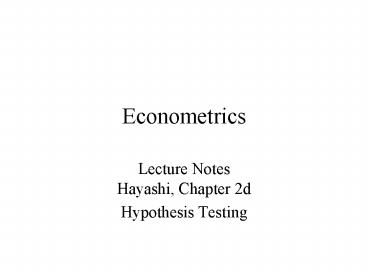Econometrics - PowerPoint PPT Presentation
1 / 12
Title:
Econometrics
Description:
Statistical inference in large-sample theory is based on test statistics whose ... For OLS estimator b of b, a consistent estimator of S = E(gigi') with gi=xiei, is ... – PowerPoint PPT presentation
Number of Views:51
Avg rating:3.0/5.0
Title: Econometrics
1
Econometrics
- Lecture Notes Hayashi, Chapter 2d
- Hypothesis Testing
2
Linear Hypothesis
- Statistical inference in large-sample theory is
based on test statistics whose asymptotic
distributions are known under the truth of null
hypothesis. - For OLS estimator b of b, a consistent estimator
of S E(gigi) with gixiei, is
3
Linear Hypothesis
- Probability of type I error is the probability of
rejecting the null hypothesis when it is true. - The finite-sample size of a test is the
probability of type I error (actual or exact
size), which equals the desired significance
level a (nominal size). - The exact size and nominal size of a test will
equal only approximately for large samples. The
difference is called size distortion.
4
Linear Hypothesis
- Probability of type II error is the probability
of not rejecting the null hypothesis when it is
false. - The finite-sample power of a test is the
probability of rejecting the null hypothesis when
it is false given a finite sample. That is, the
power is 1 minus the probability of type II
error. - Power depends on the DGPs considered as the
alternatives as well as on the size (significance
level) of the test.
5
Linear Hypothesis
- A test is consistent against a set of
alternatives (DGPs), none of which satisfies the
null, if the power against any particular member
of the set approaches unite as n??, for any
assumed significance level.
6
Linear Hypothesis (1)
7
Linear Hypothesis (1)
- SE(bk) is called the heteroscedasticity-consisten
t standard error, (heteroscedasticity) robust
standard error, or Whites standard error. - The statistic tk is called the robust t-ratio.
8
Linear Hypothesis (2)
- Under the null hypothesis H0 Rb r, where R is
JxK matrix of full row rank and J is the number
of restrictions (the dimension of r),W
n(Rb-r)REst(Avar(b))R-1(Rb-r) ?2(J)
9
Linear Hypothesis (2)
- Under A.7, or conditional homoscedasticity, W
n(Rb-r)Rns2(XX)-1R-1(Rb-r)
(Rb-r)R(XX)-1R-1(Rb-r)/s2 JF (SSRr
SSRur)/s2 ?2(J)
10
Nonlinear Hypothesis
- Under the null hypothesis with J restrictions H0
a(b) 0 such that A(b) ?a(b)/?b, the JxK
matrix of continuous first derivatives of a(b),
is of full row rank, we have W n
a(b)A(b)Est(Avar(b))A(b)-1a(b)?d ?2(J)
11
Testing for Conditional Homoscedasticity
- Robust Variance-Covariance Matrix?iei2xixi/n
?p E(ei2xixi)where ei yi xib - OLS Variance-Covariance Matrixs2?ixixi/n, where
s2 ee/(n-K) - Under homoscedasticity, ?i(ei2-s2)xixi/n ?p 0
12
Testing for Conditional Homoscedasticity
- Proposition 6 In addition to A.1 (linearity),
A.4 (rank condition), suppose that - yi,xi is i.i.d. with finite E(ei2xixi)
(stronger A.2 and A.5) - ei is independent of xi (stronger A.3 and
conditional homoscedasticity - a certain condition holds on the moments of ei
and xi - Then nR2 ?d ?2(m) for the auxiliary
regressionei2 on a constant and yi (xixi),
and m is the dimension of yi .

